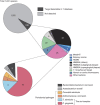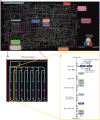Comparative genome analysis and identification of competitive and cooperative interactions in a polymicrobial disease
- PMID: 25171331
- PMCID: PMC4331577
- DOI: 10.1038/ismej.2014.155
Comparative genome analysis and identification of competitive and cooperative interactions in a polymicrobial disease
Abstract
Polymicrobial diseases are caused by combinations of multiple bacteria, which can lead to not only mild but also life-threatening illnesses. Periodontitis represents a polymicrobial disease; Porphyromonas gingivalis, Treponema denticola and Tannerella forsythia, called 'the red complex', have been recognized as the causative agents of periodontitis. Although molecular interactions among the three species could be responsible for progression of periodontitis, the relevant genetic mechanisms are unknown. In this study, we uncovered novel interactions in comparative genome analysis among the red complex species. Clustered regularly interspaced short palindromic repeats (CRISPRs) of T. forsythia might attack the restriction modification system of P. gingivalis, and possibly work as a defense system against DNA invasion from P. gingivalis. On the other hand, gene deficiencies were mutually compensated in metabolic pathways when the genes of all the three species were taken into account, suggesting that there are cooperative relationships among the three species. This notion was supported by the observation that each of the three species had its own virulence factors, which might facilitate persistence and manifestations of virulence of the three species. Here, we propose new mechanisms of bacterial symbiosis in periodontitis; these mechanisms consist of competitive and cooperative interactions. Our results might shed light on the pathogenesis of periodontitis and of other polymicrobial diseases.
Figures




Similar articles
-
Porphyromonas gingivalis and Treponema denticola synergistic polymicrobial biofilm development.PLoS One. 2013 Aug 26;8(8):e71727. doi: 10.1371/journal.pone.0071727. eCollection 2013. PLoS One. 2013. PMID: 23990979 Free PMC article.
-
Rat model of polymicrobial infection, immunity, and alveolar bone resorption in periodontal disease.Infect Immun. 2007 Apr;75(4):1704-12. doi: 10.1128/IAI.00733-06. Epub 2007 Jan 8. Infect Immun. 2007. PMID: 17210663 Free PMC article.
-
Bacterial interactions in pathogenic subgingival plaque.Microb Pathog. 2016 May;94:60-9. doi: 10.1016/j.micpath.2015.10.022. Epub 2015 Nov 2. Microb Pathog. 2016. PMID: 26541672
-
[Pathogenic potential of Porphyromonas gingivalis, Treponema denticola and Tannerella forsythia, the red bacterial complex associated with periodontitis].Pathol Biol (Paris). 2007 Apr-May;55(3-4):154-62. doi: 10.1016/j.patbio.2006.07.045. Epub 2006 Oct 17. Pathol Biol (Paris). 2007. PMID: 17049750 Review. French.
-
Periodontitis: a polymicrobial disruption of host homeostasis.Nat Rev Microbiol. 2010 Jul;8(7):481-90. doi: 10.1038/nrmicro2337. Nat Rev Microbiol. 2010. PMID: 20514045 Review.
Cited by
-
Functional signatures of oral dysbiosis during periodontitis progression revealed by microbial metatranscriptome analysis.Genome Med. 2015 Apr 27;7(1):27. doi: 10.1186/s13073-015-0153-3. eCollection 2015. Genome Med. 2015. PMID: 25918553 Free PMC article.
-
Consistent and reproducible long-term in vitro growth of health and disease-associated oral subgingival biofilms.BMC Microbiol. 2018 Jul 11;18(1):70. doi: 10.1186/s12866-018-1212-x. BMC Microbiol. 2018. PMID: 29996764 Free PMC article.
-
A review and new perspective on oral bacteriophages: manifestations in the ecology of oral diseases.J Oral Microbiol. 2024 May 1;16(1):2344272. doi: 10.1080/20002297.2024.2344272. eCollection 2024. J Oral Microbiol. 2024. PMID: 38698893 Free PMC article. Review.
-
Contribution of -Omics Technologies in the Study of Porphyromonas gingivalis during Periodontitis Pathogenesis: A Minireview.Int J Mol Sci. 2022 Dec 30;24(1):620. doi: 10.3390/ijms24010620. Int J Mol Sci. 2022. PMID: 36614064 Free PMC article. Review.
-
Role of CRISPR-Cas systems in periodontal disease pathogenesis and potential for periodontal therapy: A review.Mol Oral Microbiol. 2025 Feb;40(1):1-16. doi: 10.1111/omi.12483. Epub 2024 Sep 3. Mol Oral Microbiol. 2025. PMID: 39224035 Free PMC article. Review.
References
-
- Bikard D, Hatoum-Aslan A, Mucida D, Marraffini LA. CRISPR interference can prevent natural transformation and virulence acquisition during in vivo bacterial infection. Cell Host Microbe. 2012;12:177–186. - PubMed
-
- Bostanci N, Belibasakis GN. Porphyromonas gingivalis: an invasive and evasive opportunistic oral pathogen. FEMS Microbiol Lett. 2012;333:1–9. - PubMed
-
- Botta GA, Radin L, Costa A, Schito G, Blasi G. Gas–liquid chromatography of the gingival fluid as an aid in periodontal diagnosis. J Periodontal Res. 1985;20:450–457. - PubMed
Publication types
MeSH terms
LinkOut - more resources
Full Text Sources
Other Literature Sources
Molecular Biology Databases

